Related Research Articles

The Royal Aircraft Factory B.E.2 was a British single-engine tractor two-seat biplane designed and developed at the Royal Aircraft Factory. Most production aircraft were constructed under contract by various private companies, both established aircraft manufacturers and firms that had not previously built aircraft. Around 3,500 were manufactured in all.

Between 1911 and 1914, the Royal Aircraft Factory used the F.E.2 designation for three quite different aircraft that shared only a common "Farman" pusher biplane layout.
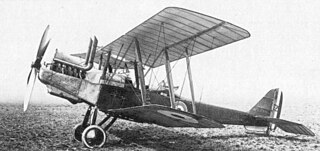
The Royal Aircraft Factory R.E.8 was a British two-seat biplane reconnaissance and bomber aircraft of the First World War designed and produced at the Royal Aircraft Factory. It was also built under contract by Austin Motors, Daimler, Standard Motors, Siddeley-Deasy and the Coventry Ordnance Works.

The Royal Aircraft Factory S.E.5 was a British biplane fighter aircraft of the First World War. It was developed at the Royal Aircraft Factory by a team consisting of Henry Folland, John Kenworthy and Major Frank Goodden. It was one of the fastest aircraft of the war, while being both stable and relatively manoeuvrable. According to aviation author Robert Jackson, the S.E.5 was: "the nimble fighter that has since been described as the 'Spitfire of World War One'".
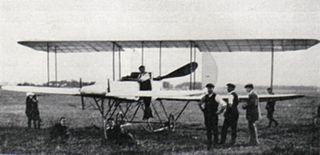
The S.E.1 was an experimental aircraft built at the Army Balloon Factory at Farnborough in 1911. Its place in aviation history is mainly that it was the first in the series of Royal Aircraft Factory designs - several of which played an important role in World War I.

The Royal Aircraft Factory F.E.1 was designed and built in 1910 by the pioneer designer Geoffrey de Havilland. He used it to teach himself to fly during late 1910. After De Havilland was appointed assistant designer and test pilot at the Army Balloon Factory at Farnborough in December 1910 the War Office bought the aircraft for £400. the aircraft was given the designation F.E.1

The Royal Aircraft Factory B.E.12 was a British single-seat aeroplane of The First World War designed at the Royal Aircraft Factory. It was essentially a single-seat version of the B.E.2.

The Royal Aircraft Factory F.E.8 was a British single-seat fighter of the First World War designed at the Royal Aircraft Factory. Although a clean and well designed little aeroplane for a pusher, it could not escape the drag penalty imposed by its tail structure and was no match for the Albatros fighters of late 1916.

The Avro 552 was a British light biplane aircraft produced in the early 1920s. It was another attempt by Avro to sell a derivative of the wartime 504 to the civil market.

The Royal Aircraft Factory B.E.9 was a British experimental reconnaissance aircraft of World War I.
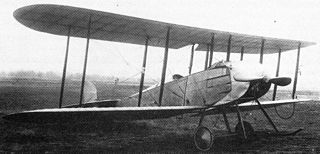
The Royal Aircraft Factory B.E.8 was a British two-seat single-engined general purpose biplane of the First World War, designed by John Kenworthy at the Royal Aircraft Factory in 1913. Small numbers were used by the Royal Flying Corps over the Western Front in the first year of the war, with the type being used as a trainer until 1916.

The Vickers F.B.12 was a biplane pusher fighter aircraft developed during World War I by Vickers Limited. The failure of the engine for which it was designed, and the obsolescence of the pusher configuration, resulted in its remaining an experimental type only.

The Vickers E.F.B.7 was a prototype British fighter aircraft of the First World War. A twin-engined biplane, the E.F.B.7 was unsuccessful, only a single example being built.
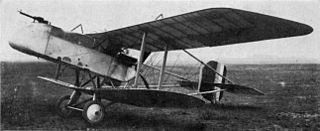
The Royal Aircraft Factory F.E.9 was a prototype British two-seat fighter-reconnaissance aircraft of the First World War. A single-engined pusher biplane of 1917, the F.E.9 had poor performance and handling, and only three were built.
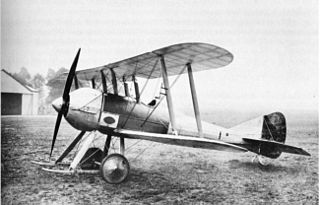
The Royal Aircraft Factory S.E.2 was an early British single-seat scout aircraft. Designed and built at the Royal Aircraft Factory in 1912–13 as the B.S.1, the prototype was rebuilt several times before serving with the Royal Flying Corps over the Western Front in the early months of the First World War.

The Royal Aircraft Factory H.R.E.2 was intended as a Naval reconnaissance floatplane. The single example built was serving with the Royal Naval Air Service at the start of World War I.
The Royal Aircraft Factory S.E.4 was a single-engined, single seat biplane designed and built at the Royal Aircraft Factory just prior to the start of the First World War. Intended to be as fast as possible, it recorded a speed of 135 mph (217 km/h), which made it the fastest aircraft in the world in 1914, but no production followed and it was soon written off in a crash.
The Royal Aircraft Factory F.E.3 (also known as the A.E.1 was a British experimental single-engined pusher biplane built prior to the First World War. It was intended to be fitted with a shell-firing gun, but was quickly abandoned, being found to be structurally unsound.
The Royal Aircraft Factory C.E.1 was a prototype British flying boat of the First World War. It was a single-engined pusher configuration biplane intended to carry out coastal patrols to protect shipping against German U-boats, but only two were built, the only flying boats to be designed and built by the Royal Aircraft Factory.
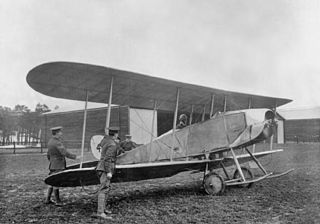
The Royal Aircraft Factory B.E.3 was a single-engined rotary engined biplane developed by the British Royal Aircraft Factory prior to the First World War. The B.E.4 and B.E.7 were virtually identical aircraft that differed only in the engine fitted.
References
- Hare, Paul R. (1990). The Royal Aircraft Factory. Putnam Aeronautical Books.
| | This article on an aircraft of the 1910s is a stub. You can help Wikipedia by expanding it. |